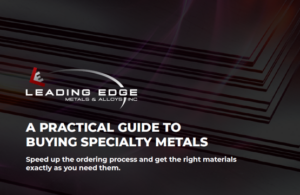Exotic and Refractory Metals in the Research Lab Industry
One of the fastest-growing and most fascinating industries we serve is national research labs. Research lab sectors include government-funded and private research institutions focused on advancing clean energy, scientific knowledge, technology, and national security. Refractory and exotic metals are indispensable in research and national labs, supporting experiments and applications that require materials capable of enduring extreme conditions, delivering high precision, and maintaining stability under rigorous testing environments.

ESSENTIAL PROPERTIES OF EXOTIC AND REFRACTORY METALS IN THE RESEARCH LAB INDUSTRY
Supporting economic growth and addressing complex challenges that impact society and the environment, we serve various research lab subsectors, primarily in advanced energy development, aerospace and defense (A&D), and materials science. National research labs rely heavily on the essential properties of refractory and exotic metals, including high melting points, strength, durability, electrical and thermal conductivity, and more.
KEY RESEARCH LAB APPLICATIONS
In research lab applications, refractory and exotic metals are essential for pushing the boundaries of scientific discovery and innovation. These metals enable advanced experiments in nuclear energy, particle physics, aerospace, and materials science, providing the durability, heat resistance, and superconducting properties needed for cutting-edge research. National research labs rely on these materials to develop future technologies and maintain a competitive edge in science and industry.
Here are some of the top sector applications and materials used.
NATIONAL
RESEARCH LAB
INDUSTRIES
Refractory and Exotic Materials in Research Lab Applications

Nuclear Fusion and Other Energy Research
National research labs are at the forefront of energy innovation, exploring solutions that could reshape our approach to power generation, sustainability, and climate resilience. One of the biggest opportunities in the research lab industry lies in nuclear fusion, which could offer an abundant, clean power source but requires breakthroughs in plasma containment and energy efficiency. We are trailblazers in supporting nuclear fusion research, providing materials, machining, and mission-critical innovation in all aspects, from traceability documentation to sterilization and serialization.
Refractory metals like Tantalum, Tungsten, Molybdenum, Niobium, and Zirconium are widely used in nuclear research, including both fusion and fission experiments. Due to their ability to withstand extreme temperatures, radiation, and corrosive environments, these materials are crucial for constructing reactor components, such as fuel cladding, neutron reflectors, and plasma-facing materials.
Laboratories developing nuclear technologies such as fusion reactors rely on these materials, our industry-leading metallurgy expertise, and our innovative machining and process capabilities for high-performance applications. Our Chief Metallurgist advises personally on all aspects, serving as a vital resource for our team, partners, and customers.

Aerospace & Defense (A&D) Applications
A&D sectors develop products and services for military and civilian markets, including commercial airplanes, military aircraft, helicopters, missiles, weapons and space systems, satellites, sensors, and defense electronics. It’s one of the most demanding industries in terms of material performance, right up there with new rocket programs and hypersonics.
National research lab initiatives in A&D are focused on developing advanced materials, propulsion systems, and cybersecurity technologies critical for national security and space exploration. Opportunities abound in areas like hypersonic technology, autonomous systems, and satellite resilience. The field faces significant challenges, including the need for robust cybersecurity to protect sensitive data, high costs of testing and prototyping, and complex regulatory compliance. Balancing rapid technological advancement with these stringent security and safety standards is a central ongoing challenge.
The need for high-strength and heat-resistant materials means exotic and refractory metals and alloys are in the mix. Space and aerospace research lab projects use refractory metals such as Titanium, Tungsten, and Molybdenum in rocket engines, spacecraft components, high-performance aerospace materials, and space exploration programs. National defense and security-related research lab projects use refractory metals like Tungsten and Molybdenum to develop high-performance materials for weapons systems, armor, and advanced sensors.

Particle Physics and High-Energy Experiments
Particle physics and high-energy research lab experiments explore the fundamental particles and forces that make up the universe. Using particle accelerators and detectors, scientists study high-energy collisions to uncover insights about subatomic particles and phenomena like dark matter, a mysterious, invisible substance thought to make up about 27% of the universe’s mass and energy, detectable only through its gravitational effects on visible matter and cosmic structures.
This research is essential for advancing our understanding of the universe’s origins and the laws governing matter and energy. Major challenges include the immense energy requirements, complex data analysis, and high costs, while the opportunities could redefine physics, technology, and cosmology.
In particle accelerators and high-energy physics experiments, exotic and refractory metals like Niobium, Tantalum, Tungsten, and Molybdenum are essential for superconducting magnets, beam collimators, and particle detectors. Niobium alloys, for example, are used in superconducting wire for large particle accelerators like those at the Conseil Européen pour la Recherche Nucléaire (CERN), French for the European Organization for Nuclear Research, the Advanced Photon Source at Argonne Laboratory and many others.

Cryogenics and Superconductivity
National research lab experiments in cryogenics and superconductivity explore extremely low-temperature physics, enabling breakthroughs in energy transmission, medical imaging, and quantum computing. Cryogenics focuses on cooling materials to near absolute zero, revealing behaviors like superconductivity—where certain materials conduct electricity without resistance, vastly increasing efficiency.
These fields hold promise for ultra-efficient power grids and powerful magnetic fields for medical and scientific applications. Challenges include the cost and complexity of maintaining extreme cold, creating scalable materials, and ensuring stable superconductive states, which are critical for their real-world applications.
Niobium alloys are essential metals in cryogenic applications, such as developing superconducting materials for quantum computing, magnetic resonance imaging (MRI), and particle accelerators. National labs and research institutions focused on low-temperature physics and superconductivity research rely on these metals to maintain superconductivity at extremely low temperatures.
Industry Standards and Requirements
Industries constantly evolve, driven by a growing demand for scientific and technological advancement. Successful experimentation must ensure material integrity, safety, performance, and compliance with strict environmental and operational regulations.
These standards typically focus on aspects like purity, quality, and durability to guarantee that refractory metals meet the demanding conditions of high-stakes research applications. Because they serve multiple industries and extreme environments, this list includes more than average standards and requirements.
Standards and Requirements:
- ASTM International (American Society of Mechanical Engineers): Standards for materials used in energy applications.
- SAE Aerospace Material Specifications (AMS, formerly known as the Society of Automotive Engineers or SAE)
- ASME BPVC (Boiler and Pressure Vessel Code): Guidelines for materials used in pressure vessels and reactors.
- Department of Defense (DoD) Military Standards or Military Specifications (MIL) on the Defense Logistics Agency (DLA) ASSIST Database
We adhere to quality compliance certification standards and statutory regulations that pertain to our exotic materials, processes, custom machining services, traceability, and other aspects of our in-house expertise. Our materials specialists provide expert counsel on metal selection and inspection to ensure you receive materials that meet or exceed your expectations.
Leading Edge Metals & Alloys Certifications include:
- ISO9001:2015 and AS9100D Registered
- ITAR Registered
- NIST SP 800-171 and CMMC Complian
Our deep understanding of this industry stems from our extensive experience, skilled metallurgy professionals, and a history of successful partnerships with leading national research labs.
The Bottom Line on Materials in the Research Lab Industry
The research lab industry depends on refractory and exotic metals because of their unique abilities and properties. These metals enable cutting-edge research and innovation, from advancing nuclear fusion and materials science to supporting breakthroughs in particle physics and quantum computing.
Why the Research Lab Industry Buys Rare and Exotic Metals
High Melting Points: High-temperature applications in nuclear research, particle accelerators, and materials science where components must withstand intense heat without degrading.
Strength & Durability: High resistance to wear and corrosion, crucial for applications in high-energy physics, aerospace research, and defense experiments where materials face extreme conditions.
Radiation Resistance: Highly resistant to radiation damage, ideal for nuclear research applications, shielding, and containment where materials must endure prolonged exposure to intense radiation.
Electrical Conductivity: Enabling powerful, energy-efficient electromagnets and devices critical for advanced experimentation and invaluable for research in particle physics, quantum computing, and magnetic resonance imaging.
Thermal Conductivity and Stability: Allows efficient heat dissipation in high-power experiments, like those in fusion research or high-energy lasers, maintaining system stability and protecting other components.
Formability: Ability to be molded or fabricated into extremely tight tolerances to create complex components without cracking or losing their desirable properties to meet rigorous standards and demands and ensure optimal performance and safety.
Key Research Lab Metals We Offer
Tungsten: Essential in nuclear fusion as a heat-resistant material in plasma-facing applications and medical research as an effective radiation shield with an exceptionally high melting point (over 3,400°C) and density. It is essential where high density in a small space is needed. Excellent radiation shielding properties. Explore Tungsten
Tantalum: Commonly applied for its high melting point, corrosion resistance, and excellent electrical conductivity in high-temperature studies, high-performance capacitors, and particle accelerators. Explore Tantalum
Niobium: Excellent formability and superconducting properties at cryogenic temperatures, frequently alloyed and used in particle physics labs, quantum computing research, and medical imaging facilities. Explore Niobium
Molybdenum: High melting point, mechanical strength, and corrosion resistance, ideal for applications exposed to extreme heat and radiation, as well as maintaining integrity under thermal stress in nuclear reactors and advanced energy systems. Explore Molybdenum
Zirconium: Another radiation and corrosion-resistant material with a high melting point, Zirconium also has low neutron absorption, making it ideal for nuclear research, especially in fuel rod cladding in reactors. Explore Zirconium
Other Exotic & Refractory Metals: These are the top materials used in the research lab environments we support most, but we offer others, and all of our metals have a place somewhere in this ecosystem. Explore Materials





